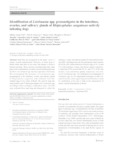Please use this identifier to cite or link to this item:
http://www.alice.cnptia.embrapa.br/alice/handle/doc/1050014| Title: | Identification of Leishmania spp. promastigotes in the intestines, ovaries, and salivary glands of Rhipicephalus sanguineus actively infesting dogs. |
| Authors: | VIOL, M. A.  GUERRERO, F. D.   OLIVEIRA, B. C. M. de   AQUINO, M. C. C. de   LOIOLA, S. H.   MELO, G. D. de   GOMES, A. H. de S.   KANAMURA, C. T.   GARCIA, M. V.   ANDREOTTI, R.   LIMA, V. M. F. de   BRESCIANI, K. D. S.   |
| Affiliation: | Milena Araúz Viol, UNESP; Felix D. Guerrero, UNESP; Bruno César Miranda de Oliveira, UNESP; Monally Conceição Costa de Aquino, UNESP; Saulo Hudson Loiola, UNESP; Guilherme Dias de Melo, UNESP; Aparecida Helena de Souza Gomes, Instituto Adolfo Lutz; Cristina Takami Kanamura, INSTITUTO ADOLFO LUTZ; Marcos Valério Garcia, FUNDECT; RENATO ANDREOTTI E SILVA, CNPGC; Valéria Marçal Félix de Lima, UNESP; Katia Denise Saraiva Bresciani, UNESP. |
| Date Issued: | 2016 |
| Citation: | Parasitology Research, v. 115, n, 9, p. 3479-3484, sept. 2016. |
| Description: | Sand flies are recognized as the major vector of canine visceral leishmaniasis. However, in some areas of Brazil where sand flies do not occur, this disease is found in humans and dogs. There has been speculation that ticks might play a role in transmission of canine visceral leishmaniasis and the DNA of Leishmania spp. has been reported in whole ticks. We investigated the presence of Leishmania spp. promastigotes in the intestines, ovaries, and salivary glands of Rhipicephalus sanguineus ticks collected from tickinfested dogs in two cities of Brazil. We used 66 dogs that tested positive and 33 that tested negative for Leishmania spp. according to direct cytological examination assays. Ten ticks were collected from each dog and dissected to collect the intestines, ovaries, and salivary glands for immunohistochemistry (IHC) and diagnostic real-time polymerase chain reaction (RT-PCR). IHC results showed Leishmania spp. in 98, 14, and 8 % of the intestines, ovaries, and salivary glands, respectively. Real-time PCR showed that 89, 41, and 33 % of the tick intestine, ovary, and salivary glands, respectively, were positive for Leishmania spp. The verification of promastigotes of Leishmania spp. by two independent techniques in ticks collected from these urban region dogs showed that there is need for clarification of the role of ticks in the transmission of canine visceral leishmaniasis in Brazil. |
| Thesagro: | Cão Leishmaniose Carrapato |
| NAL Thesaurus: | Leishmaniasis Dogs Immunohistochemistry Quantitative polymerase chain reaction |
| Keywords: | Ixodids |
| Type of Material: | Artigo de periódico |
| Access: | openAccess |
| Appears in Collections: | Artigo em periódico indexado (CNPGC)  |
Files in This Item:
| File | Description | Size | Format | |
|---|---|---|---|---|
| IdentificationofLeishmaniaspp.promastigotes.pdf | 528.24 kB | Adobe PDF |  View/Open |









